2019 MERCEDES-BENZ SLC window
[x] Cancel search: windowPage 45 of 306
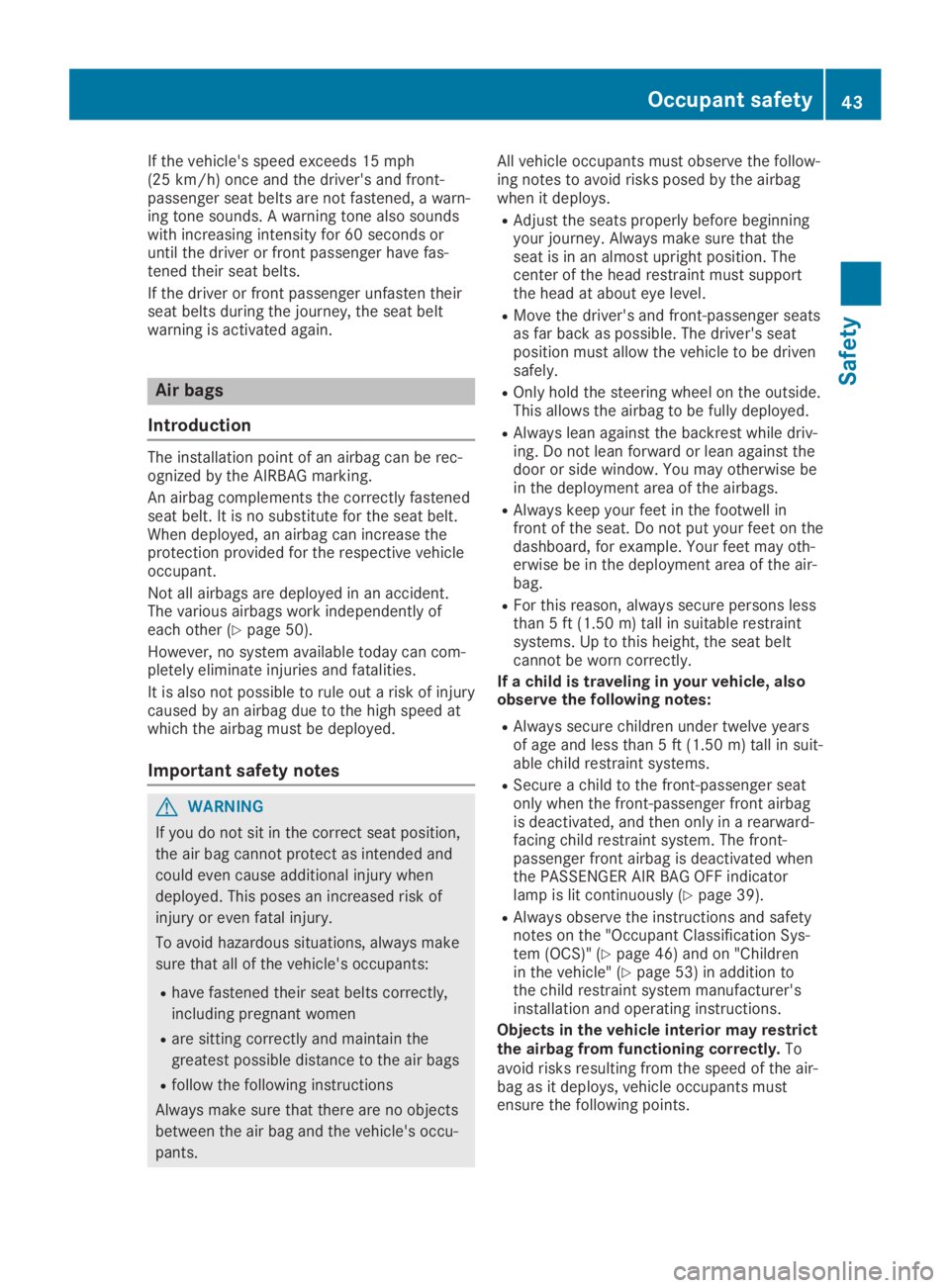
If the vehicle's speed exceeds 15 mph(25 km/h) once and the driver's and front-passenger seat belts are not fastened, a warn-ing tone sounds. A warning tone also soundswith increasing intensity for 60 seconds oruntil the driver or front passenger have fas-tened their seat belts.
If the driver or front passenger unfasten theirseat belts during the journey, the seat beltwarning is activated again.
Air bags
Introduction
The installation point of an airbag can be rec-ognized by the AIRBAG marking.
An airbag complements the correctly fastenedseat belt. It is no substitute for the seat belt.When deployed, an airbag can increase theprotection provided for the respective vehicleoccupant.
Not all airbags are deployed in an accident.The various airbags work independently ofeach other (Ypage 50).
However, no system available today can com-pletely eliminate injuries and fatalities.
It is also not possible to rule out a risk of injurycaused by an airbag due to the high speed atwhich the airbag must be deployed.
Important safety notes
GWARNING
If you do not sit in the correct seat position,
the air bag cannot protect as intended and
could even cause additional injury when
deployed. This poses an increased risk of
injury or even fatal injury.
To avoid hazardous situations, always make
sure that all of the vehicle's occupants:
Rhave fastened their seat belts correctly,
including pregnant women
Rare sitting correctly and maintain the
greatest possible distance to the air bags
Rfollow the following instructions
Always make sure that there are no objects
between the air bag and the vehicle's occu-
pants.
All vehicle occupants must observe the follow-ing notes to avoid risks posed by the airbagwhen it deploys.
RAdjust the seats properly before beginningyour journey. Always make sure that theseat is in an almost upright position. Thecenter of the head restraint must supportthe head at about eye level.
RMove the driver's and front-passenger seatsas far back as possible. The driver's seatposition must allow the vehicle to be drivensafely.
ROnly hold the steering wheel on the outside.This allows the airbag to be fully deployed.
RAlways lean against the backrest while driv-ing. Do not lean forward or lean against thedoor or side window. You may otherwise bein the deployment area of the airbags.
RAlways keep your feet in the footwell infront of the seat. Do not put your feet on thedashboard, for example. Your feet may oth-erwise be in the deployment area of the air-bag.
RFor this reason, always secure persons lessthan 5 ft (1.50 m) tall in suitable restraintsystems. Up to this height, the seat beltcannot be worn correctly.
If a child is traveling in your vehicle, alsoobserve the following notes:
RAlways secure children under twelve yearsof age and less than 5 ft (1.50 m) tall in suit-able child restraint systems.
RSecure a child to the front-passenger seatonly when the front-passenger front airbagis deactivated, and then only in a rearward-facing child restraint system. The front-passenger front airbag is deactivated whenthe PASSENGER AIR BAG OFF indicatorlamp is lit continuously (Ypage 39).
RAlways observe the instructions and safetynotes on the "Occupant Classification Sys-tem (OCS)" (Ypage 46) and on "Childrenin the vehicle" (Ypage 53) in addition tothe child restraint system manufacturer'sinstallation and operating instructions.
Objects in the vehicle interior may restrictthe airbag from functioning correctly.Toavoid risks resulting from the speed of the air-bag as it deploys, vehicle occupants mustensure the following points.
Occupant safety43
Safety
Z
Page 46 of 306
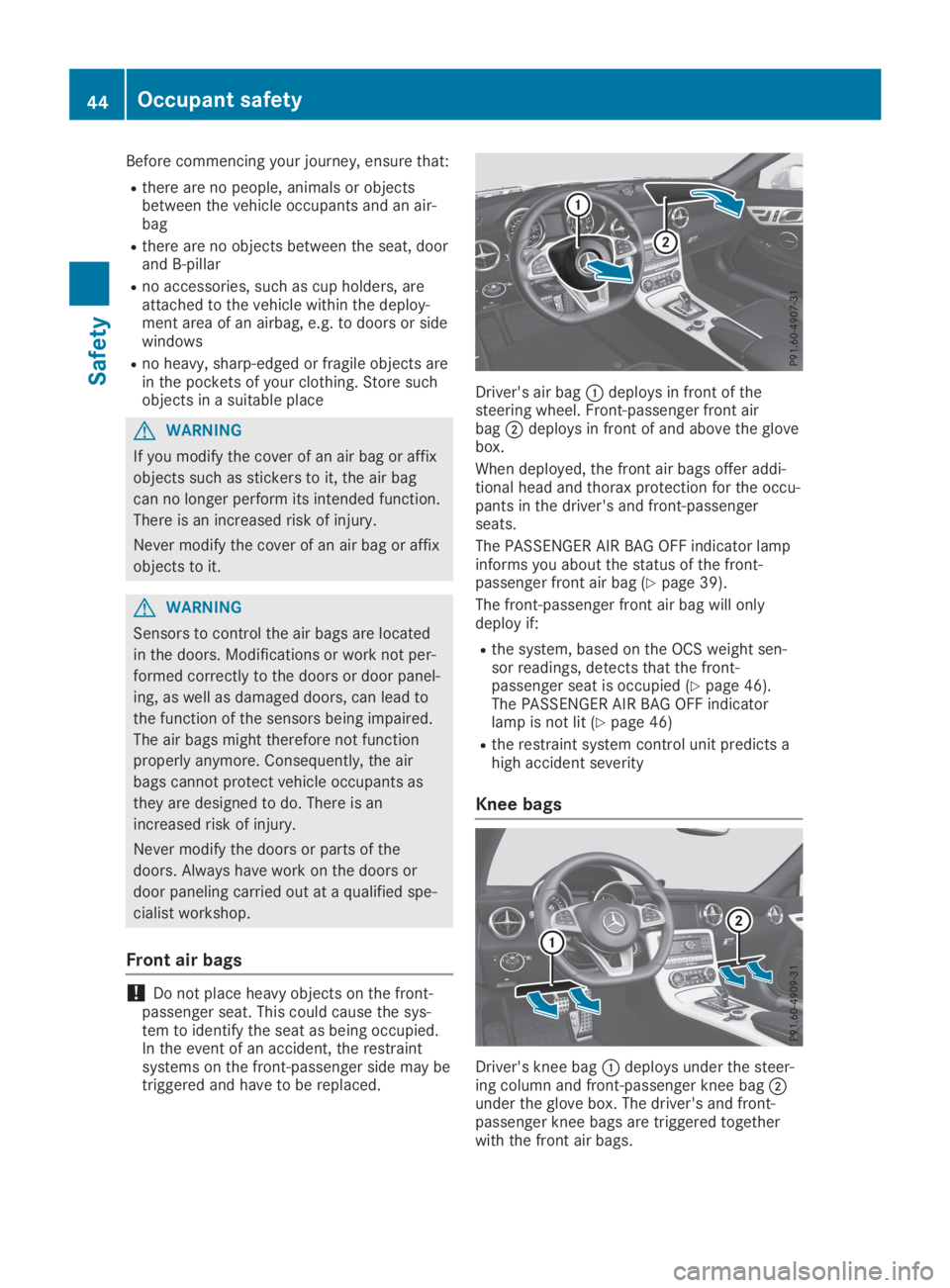
Before commencing your journey, ensure that:
Rthere are no people, animals or objectsbetween the vehicle occupants and an air-bag
Rthere are no objects between the seat, doorand B-pillar
Rno accessories, such as cup holders, areattached to the vehicle within the deploy-ment area of an airbag, e.g. to doors or sidewindows
Rno heavy, sharp-edged or fragile objects arein the pockets of your clothing. Store suchobjects in a suitable place
GWARNING
If you modify the cover of an air bag or affix
objects such as stickers to it, the air bag
can no longer perform its intended function.
There is an increased risk of injury.
Never modify the cover of an air bag or affix
objects to it.
GWARNING
Sensors to control the air bags are located
in the doors. Modifications or work not per-
formed correctly to the doors or door panel-
ing, as well as damaged doors, can lead to
the function of the sensors being impaired.
The air bags might therefore not function
properly anymore. Consequently, the air
bags cannot protect vehicle occupants as
they are designed to do. There is an
increased risk of injury.
Never modify the doors or parts of the
doors. Always have work on the doors or
door paneling carried out at a qualified spe-
cialist workshop.
Front air bags
!Do not place heavy objects on the front-passenger seat. This could cause the sys-tem to identify the seat as being occupied.In the event of an accident, the restraintsystems on the front-passenger side may betriggered and have to be replaced.
Driver's air bag�Cdeploys in front of thesteering wheel. Front-passenger front airbag�Ddeploys in front of and above the glovebox.
When deployed, the front air bags offer addi-tional head and thorax protection for the occu-pants in the driver's and front-passengerseats.
The PASSENGER AIR BAG OFF indicator lampinforms you about the status of the front-passenger front air bag (Ypage 39).
The front-passenger front air bag will onlydeploy if:
Rthe system, based on the OCS weight sen-sor readings, detects that the front-passenger seat is occupied (Ypage 46).The PASSENGER AIR BAG OFF indicatorlamp is not lit (Ypage 46)
Rthe restraint system control unit predicts ahigh accident severity
Knee bags
Driver's knee bag�Cdeploys under the steer-ing column and front-passenger knee bag�Dunder the glove box. The driver's and front-passenger knee bags are triggered togetherwith the front air bags.
44Occupant safety
Safety
Page 47 of 306
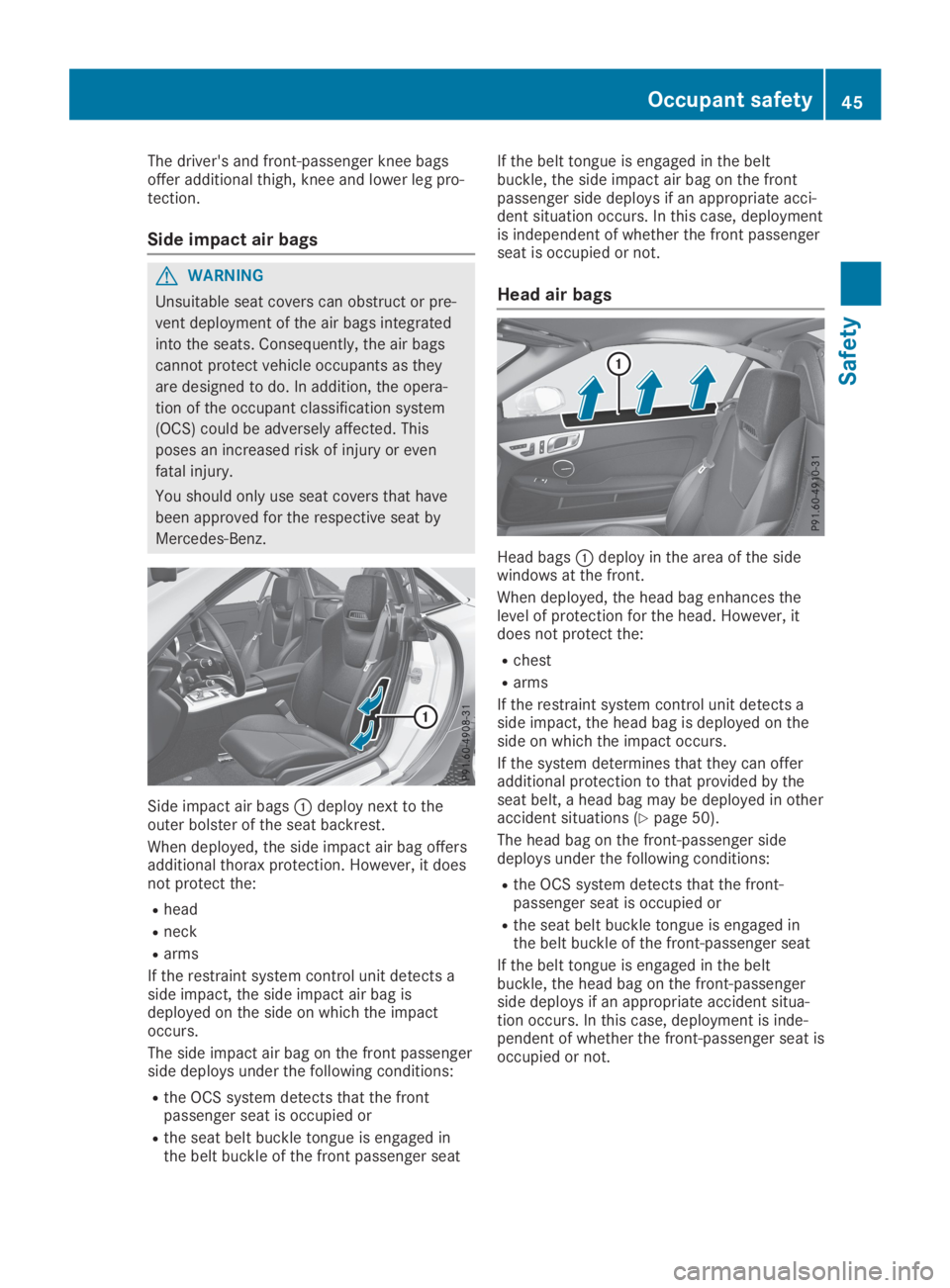
The driver's and front-passenger knee bagsoffer additional thigh, knee and lower leg pro-tection.
Side impact air bags
GWARNING
Unsuitable seat covers can obstruct or pre-
vent deployment of the air bags integrated
into the seats. Consequently, the air bags
cannot protect vehicle occupants as they
are designed to do. In addition, the opera-
tion of the occupant classification system
(OCS) could be adversely affected. This
poses an increased risk of injury or even
fatal injury.
You should only use seat covers that have
been approved for the respective seat by
Mercedes-Benz.
Side impact air bags�Cdeploy next to theouter bolster of the seat backrest.
When deployed, the side impact air bag offersadditional thorax protection. However, it doesnot protect the:
Rhead
Rneck
Rarms
If the restraint system control unit detects aside impact, the side impact air bag isdeployed on the side on which the impactoccurs.
The side impact air bag on the front passengerside deploys under the following conditions:
Rthe OCS system detects that the frontpassenger seat is occupied or
Rthe seat belt buckle tongue is engaged inthe belt buckle of the front passenger seat
If the belt tongue is engaged in the beltbuckle, the side impact air bag on the frontpassenger side deploys if an appropriate acci-dent situation occurs. In this case, deploymentis independent of whether the front passengerseat is occupied or not.
Head air bags
Head bags�Cdeploy in the area of the sidewindows at the front.
When deployed, the head bag enhances thelevel of protection for the head. However, itdoes not protect the:
Rchest
Rarms
If the restraint system control unit detects aside impact, the head bag is deployed on theside on which the impact occurs.
If the system determines that they can offeradditional protection to that provided by theseat belt, a head bag may be deployed in otheraccident situations (Ypage 50).
The head bag on the front-passenger sidedeploys under the following conditions:
Rthe OCS system detects that the front-passenger seat is occupied or
Rthe seat belt buckle tongue is engaged inthe belt buckle of the front-passenger seat
If the belt tongue is engaged in the beltbuckle, the head bag on the front-passengerside deploys if an appropriate accident situa-tion occurs. In this case, deployment is inde-pendent of whether the front-passenger seat isoccupied or not.
Occupant safety45
Safety
Z
Page 53 of 306

function for the vehicle occupants in the eventof a crash.
GWARNING
Emergency Tensioning Devices that have
deployed pyrotechnically are no longer
operational and are unable to perform their
intended protective function. This poses an
increased risk of injury or even fatal injury.
Have pyrotechnically triggered Emergency
Tensioning Devices replaced immediately at
a qualified specialist workshop.
An electric motor is used by PRE-SAFE®totrigger the tightening of the seat belt in haz-ardous situations. This procedure is reversible.
If Emergency Tensioning Devices are triggeredor air bags are deployed, you will hear a bang,and some powder may also be released. The�urestraint system warning lamp lights up.
Only in rare cases will the bang affect yourhearing. The powder that is released generallydoes not constitute a health hazard, but it maycause short-term breathing difficulties in peo-ple with asthma or other respiratory problems.Provided it is safe to do so, you should leavethe vehicle immediately or open the window inorder to prevent breathing difficulties.
Air bags and pyrotechnic Emergency Tension-ing Devices (ETDs) contain perchlorate mate-rial, which may require special handling andregard for the environment. National guide-lines must be observed during disposal. In Cal-ifornia, seewww.dtsc.ca.gov/HazardousWaste/Perchlorate/index.cfm.
Method of operation
During the first stage of a collision, therestraint system control unit evaluates impor-tant physical data relating to vehicle decelera-tion or acceleration, such as:
Rduration
Rdirection
Rintensity
Based on the evaluation of this data, therestraint system control unit triggers the Emer-gency Tensioning Devices during a head-on orrear-end collision.
An Emergency Tensioning Device can only betriggered, if:
Rthe ignition is switched on
Rthe components of the restraint system areoperational. You can find further informationunder "Restraint system warning lamp"(Ypage 39)
Rthe seat belt buckle tongue has engaged inthe belt buckle of the respective seat
If the restraint system control unit detects amore severe accident, further components ofthe restraint system are activated independ-ently of each other in certain frontal collisionsituations:
RFront air bags as well as driver's and front-passenger knee bags
Depending on the person in the front-passenger seat, the front-passenger front airbag is either enabled or disabled. The front-passenger front air bag can be deployed in anaccident only if the PASSENGER AIR BAG OFFindicator lamp is off. Observe the informationon the PASSENGER AIR BAG indicator lamps(Ypage 39).
Your vehicle has two-stage front air bags.
The activation threshold of the EmergencyTensioning Devices and the air bags is deter-mined by evaluating the rate of vehicle decel-eration or acceleration which occurs at variouspoints in the vehicle. This process is pre-emp-tive in nature. Deployment should take placein good time at the start of the collision.
The rate of vehicle deceleration or accelera-tion and the direction of the force are essen-tially determined by:
Rthe distribution of forces during the collision
Rthe collision angle
Rthe deformation characteristics of the vehi-cle
Rthe characteristics of the object with whichthe vehicle has collided
Factors which can only be seen and measuredafter a collision has occurred do not play adecisive role in the deployment of an air bag.Nor do they provide an indication of air bagdeployment.
The vehicle can be deformed considerably,without an air bag being deployed. This is thecase if only parts which are relatively easilydeformed are affected and the rate of deceler-ation is not high. Conversely, air bags may bedeployed even though the vehicle suffers only
Occupant safety51
Safety
Z
Page 73 of 306
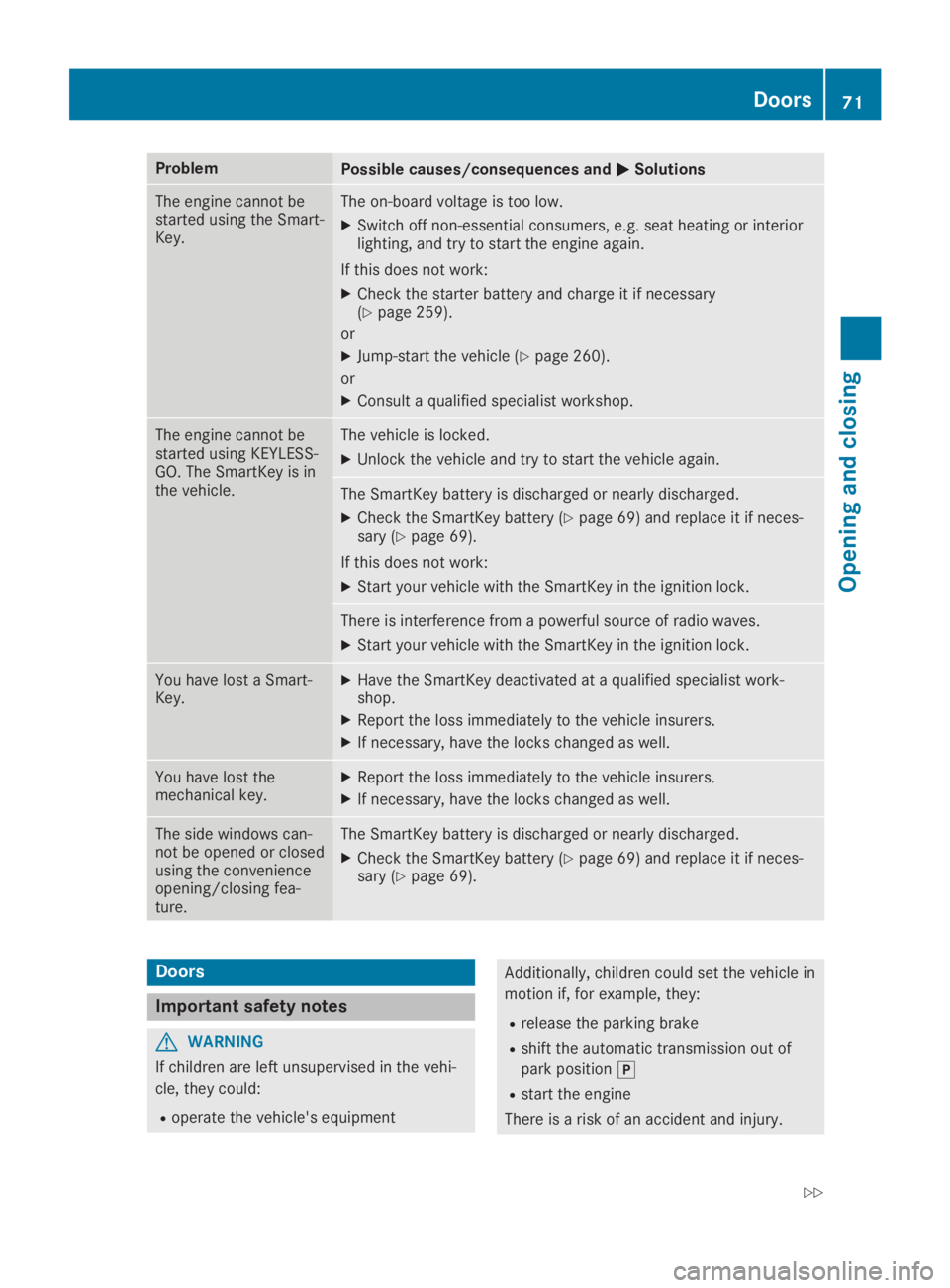
ProblemPossible causes/consequences and�P�PSolutions
The engine cannot bestarted using the Smart-Key.
The on-board voltage is too low.
XSwitch off non-essential consumers, e.g. seat heating or interiorlighting, and try to start the engine again.
If this does not work:
XCheck the starter battery and charge it if necessary(Ypage 259).
or
XJump-start the vehicle (Ypage 260).
or
XConsult a qualified specialist workshop.
The engine cannot bestarted using KEYLESS-GO. The SmartKey is inthe vehicle.
The vehicle is locked.
XUnlock the vehicle and try to start the vehicle again.
The SmartKey battery is discharged or nearly discharged.
XCheck the SmartKey battery (Ypage 69) and replace it if neces-sary (Ypage 69).
If this does not work:
XStart your vehicle with the SmartKey in the ignition lock.
There is interference from a powerful source of radio waves.
XStart your vehicle with the SmartKey in the ignition lock.
You have lost a Smart-Key.XHave the SmartKey deactivated at a qualified specialist work-shop.
XReport the loss immediately to the vehicle insurers.
XIf necessary, have the locks changed as well.
You have lost themechanical key.XReport the loss immediately to the vehicle insurers.
XIf necessary, have the locks changed as well.
The side windows can-not be opened or closedusing the convenienceopening/closing fea-ture.
The SmartKey battery is discharged or nearly discharged.
XCheck the SmartKey battery (Ypage 69) and replace it if neces-sary (Ypage 69).
Doors
Important safety notes
GWARNING
If children are left unsupervised in the vehi-
cle, they could:
Roperate the vehicle's equipment
Additionally, children could set the vehicle in
motion if, for example, they:
Rrelease the parking brake
Rshift the automatic transmission out of
park position�]
Rstart the engine
There is a risk of an accident and injury.
Doors71
Opening and closing
Z
Page 74 of 306
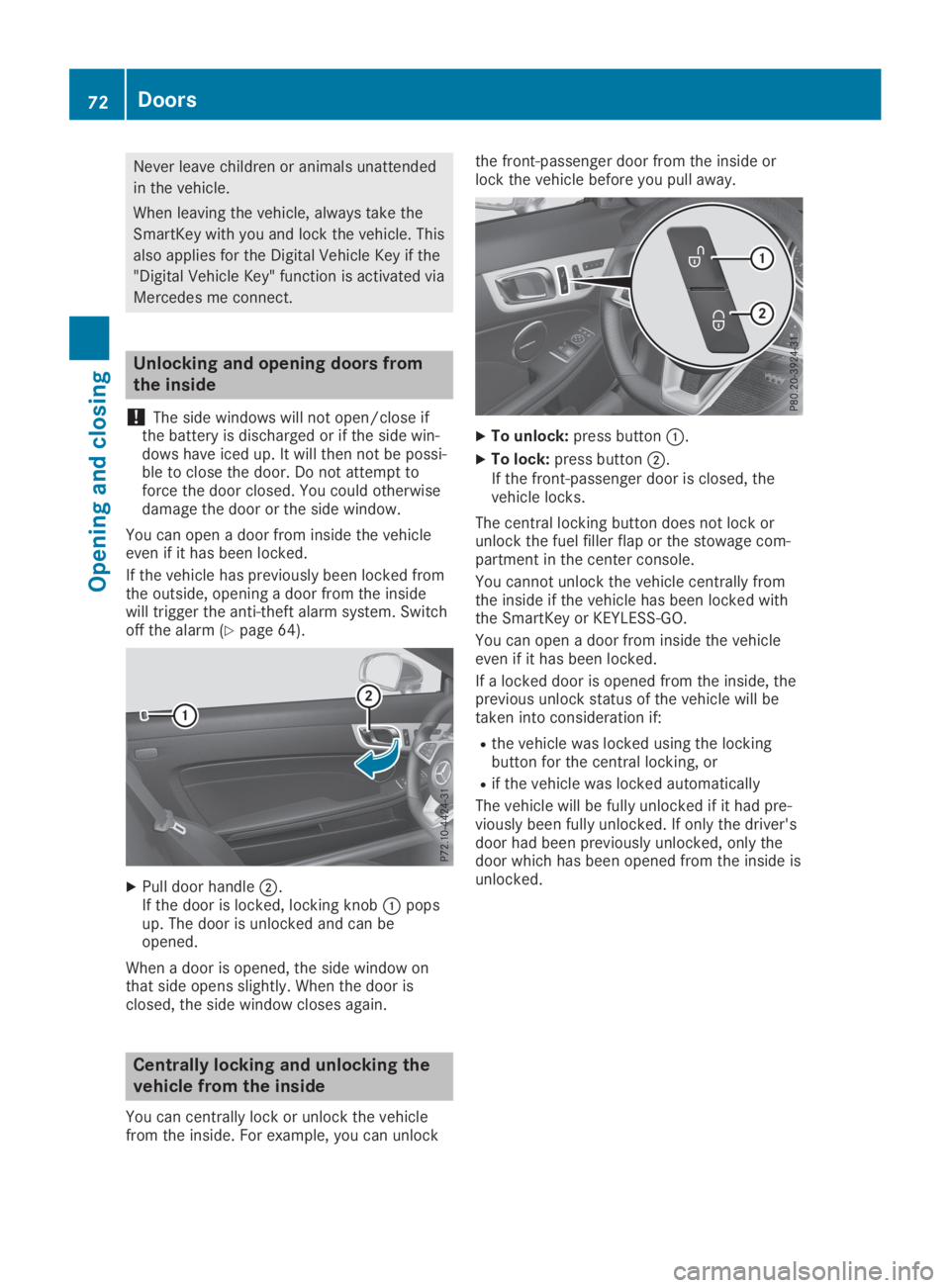
Never leave children or animals unattended
in the vehicle.
When leaving the vehicle, always take the
SmartKey with you and lock the vehicle. This
also applies for the Digital Vehicle Key if the
"Digital Vehicle Key" function is activated via
Mercedes me connect.
Unlocking and opening doors from
the inside
!The side windows will not open/close ifthe battery is discharged or if the side win-dows have iced up. It will then not be possi-ble to close the door. Do not attempt toforce the door closed. You could otherwisedamage the door or the side window.
You can open a door from inside the vehicleeven if it has been locked.
If the vehicle has previously been locked fromthe outside, opening a door from the insidewill trigger the anti-theft alarm system. Switchoff the alarm (Ypage 64).
XPull door handle�D.If the door is locked, locking knob�Cpopsup. The door is unlocked and can beopened.
When a door is opened, the side window onthat side opens slightly. When the door isclosed, the side window closes again.
Centrally locking and unlocking the
vehicle from the inside
You can centrally lock or unlock the vehiclefrom the inside. For example, you can unlock
the front-passenger door from the inside orlock the vehicle before you pull away.
XTo unlock:press button�C.
XTo lock:press button�D.If the front-passenger door is closed, thevehicle locks.
The central locking button does not lock orunlock the fuel filler flap or the stowage com-partment in the center console.
You cannot unlock the vehicle centrally fromthe inside if the vehicle has been locked withthe SmartKey or KEYLESS-GO.
You can open a door from inside the vehicleeven if it has been locked.
If a locked door is opened from the inside, theprevious unlock status of the vehicle will betaken into consideration if:
Rthe vehicle was locked using the lockingbutton for the central locking, or
Rif the vehicle was locked automatically
The vehicle will be fully unlocked if it had pre-viously been fully unlocked. If only the driver'sdoor had been previously unlocked, only thedoor which has been opened from the inside isunlocked.
72Doors
Opening and closing
Page 77 of 306
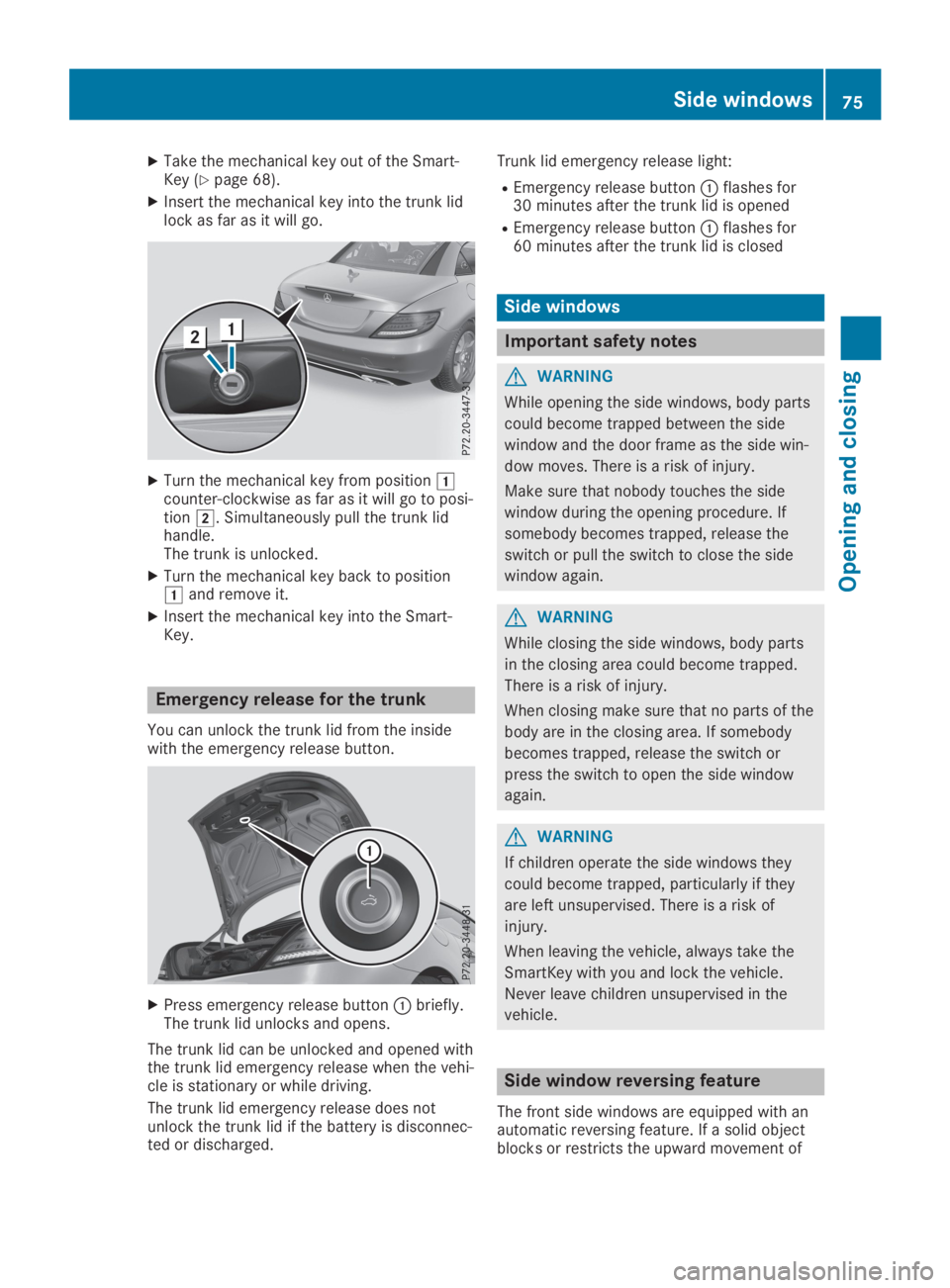
XTake the mechanical key out of the Smart-Key (Ypage 68).
XInsert the mechanical key into the trunk lidlock as far as it will go.
XTurn the mechanical key from position�Gcounter-clockwise as far as it will go to posi-tion�H. Simultaneously pull the trunk lidhandle.The trunk is unlocked.
XTurn the mechanical key back to position�Gand remove it.
XInsert the mechanical key into the Smart-Key.
Emergency release for the trunk
You can unlock the trunk lid from the insidewith the emergency release button.
XPress emergency release button�Cbriefly.The trunk lid unlocks and opens.
The trunk lid can be unlocked and opened withthe trunk lid emergency release when the vehi-cle is stationary or while driving.
The trunk lid emergency release does notunlock the trunk lid if the battery is disconnec-ted or discharged.
Trunk lid emergency release light:
REmergency release button�Cflashes for30 minutes after the trunk lid is opened
REmergency release button�Cflashes for60 minutes after the trunk lid is closed
Side windows
Important safety notes
GWARNING
While opening the side windows, body parts
could become trapped between the side
window and the door frame as the side win-
dow moves. There is a risk of injury.
Make sure that nobody touches the side
window during the opening procedure. If
somebody becomes trapped, release the
switch or pull the switch to close the side
window again.
GWARNING
While closing the side windows, body parts
in the closing area could become trapped.
There is a risk of injury.
When closing make sure that no parts of the
body are in the closing area. If somebody
becomes trapped, release the switch or
press the switch to open the side window
again.
GWARNING
If children operate the side windows they
could become trapped, particularly if they
are left unsupervised. There is a risk of
injury.
When leaving the vehicle, always take the
SmartKey with you and lock the vehicle.
Never leave children unsupervised in the
vehicle.
Side window reversing feature
The front side windows are equipped with anautomatic reversing feature. If a solid objectblocks or restricts the upward movement of
Side windows75
Opening and closing
Z
Page 78 of 306
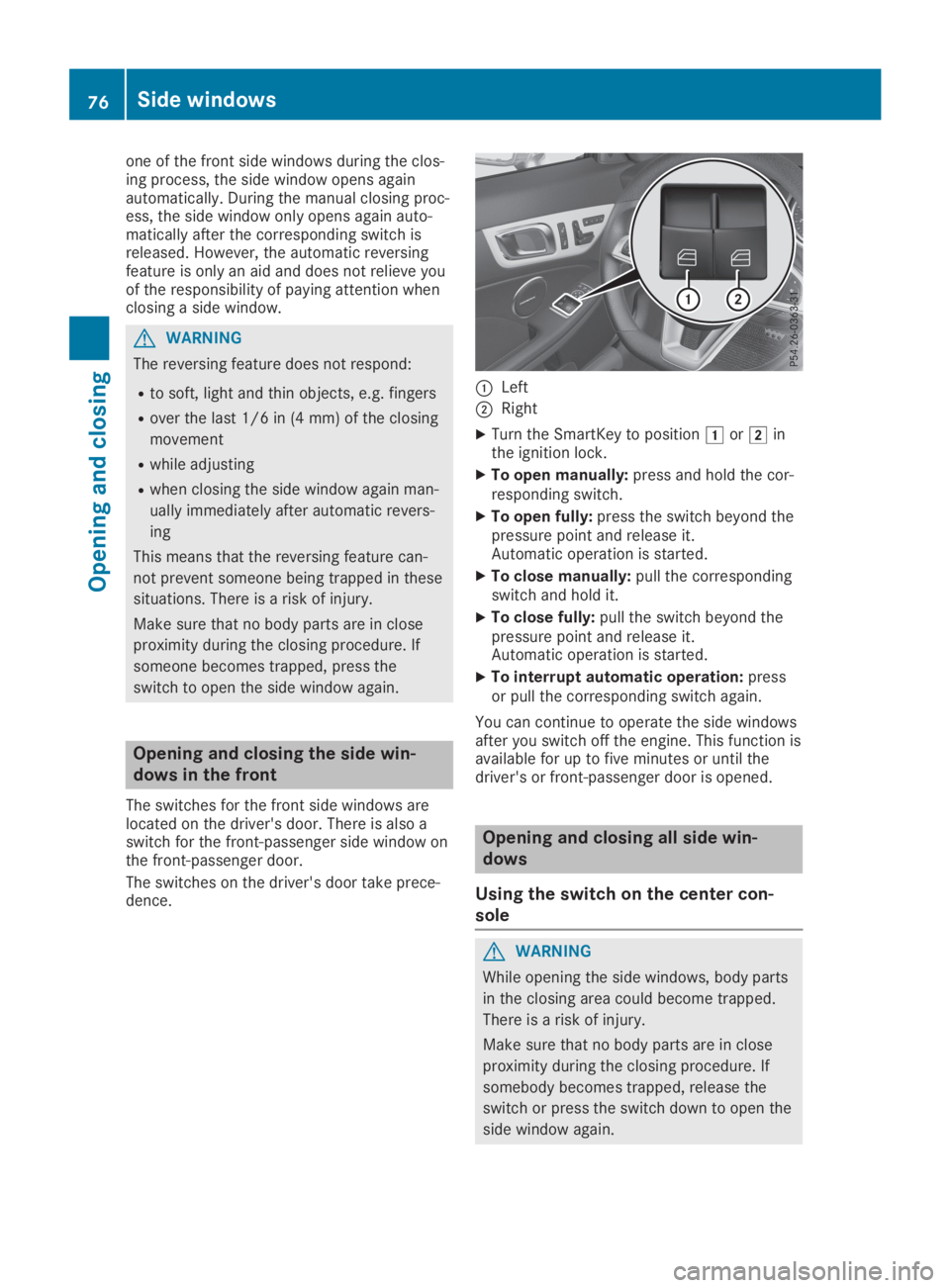
one of the front side windows during the clos-ing process, the side window opens againautomatically. During the manual closing proc-ess, the side window only opens again auto-matically after the corresponding switch isreleased. However, the automatic reversingfeature is only an aid and does not relieve youof the responsibility of paying attention whenclosing a side window.
GWARNING
The reversing feature does not respond:
Rto soft, light and thin objects, e.g. fingers
Rover the last 1/6 in (4 mm) of the closing
movement
Rwhile adjusting
Rwhen closing the side window again man-
ually immediately after automatic revers-
ing
This means that the reversing feature can-
not prevent someone being trapped in these
situations. There is a risk of injury.
Make sure that no body parts are in close
proximity during the closing procedure. If
someone becomes trapped, press the
switch to open the side window again.
Opening and closing the side win-
dows in the front
The switches for the front side windows arelocated on the driver's door. There is also aswitch for the front-passenger side window onthe front-passenger door.
The switches on the driver's door take prece-dence.
�CLeft
�DRight
XTurn the SmartKey to position�Gor�Hinthe ignition lock.
XTo open manually:press and hold the cor-responding switch.
XTo open fully:press the switch beyond thepressure point and release it.Automatic operation is started.
XTo close manually:pull the correspondingswitch and hold it.
XTo close fully:pull the switch beyond thepressure point and release it.Automatic operation is started.
XTo interrupt automatic operation:pressor pull the corresponding switch again.
You can continue to operate the side windowsafter you switch off the engine. This function isavailable for up to five minutes or until thedriver's or front-passenger door is opened.
Opening and closing all side win-
dows
Using the switch on the center con-
sole
GWARNING
While opening the side windows, body parts
in the closing area could become trapped.
There is a risk of injury.
Make sure that no body parts are in close
proximity during the closing procedure. If
somebody becomes trapped, release the
switch or press the switch down to open the
side window again.
76Side windows
Opening and closing